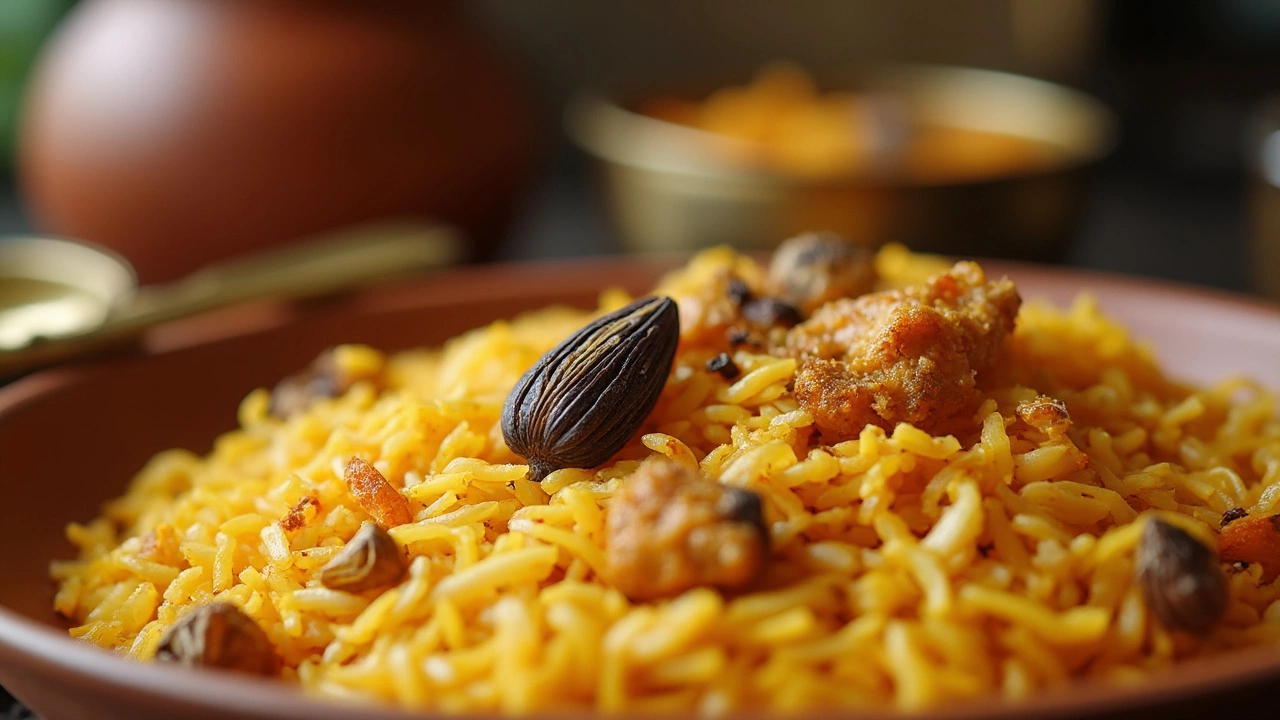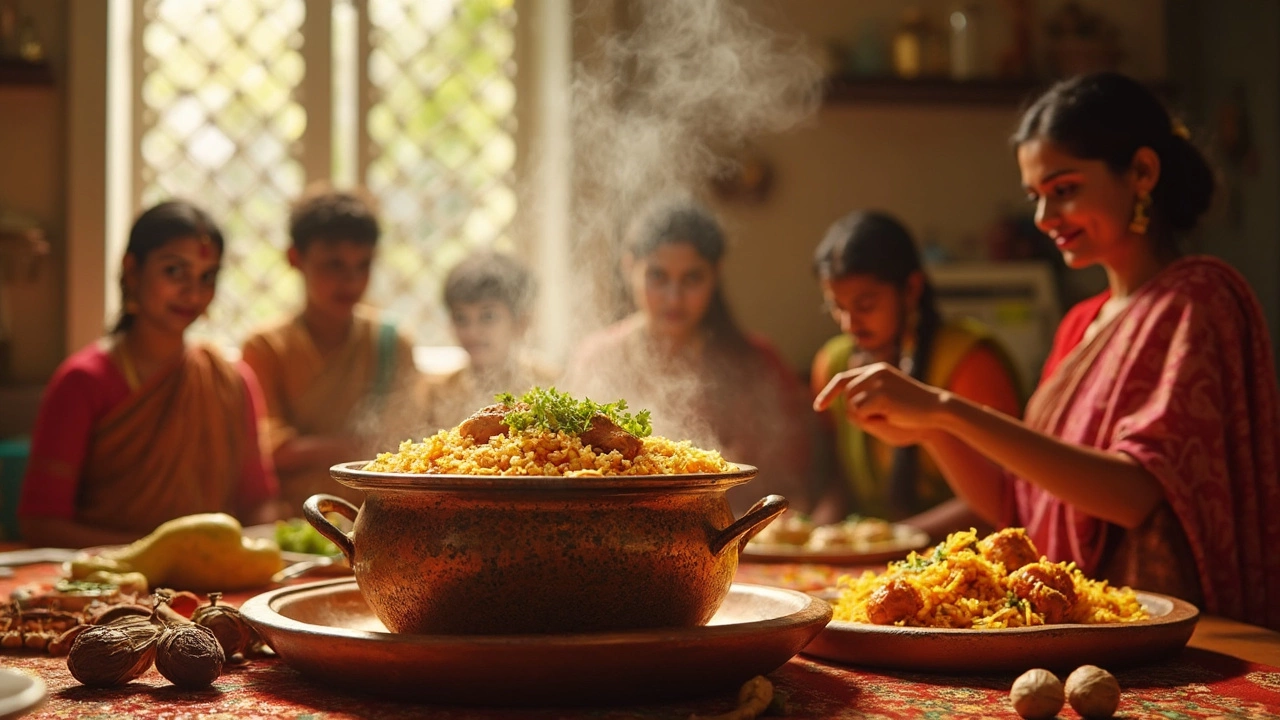Ever paused mid-bite because you found a weird little black thing in your biryani? You’re not the only one. Most people think it’s a burnt clove or piece of charcoal, but that tiny black thing is actually one of the spices that makes biryani taste amazing—usually a whole black cardamom pod, clove, or even a black peppercorn.
These small black bits might look odd if you’re not used to spotting spices in your food. Trust me, they aren’t there by accident. Chefs add them before cooking to give the rice its signature aroma and bold flavor. So if you bite into something crunchy and super aromatic, it’s probably a cardamom pod or a clove doing its job.
- Spotting the Mystery: What Is That Black Thing?
- Black Cardamom vs. Other Black Bits
- Why Spices Are Left Whole in Biryani
- Tips for Cooking and Eating Biryani Like a Pro
Spotting the Mystery: What Is That Black Thing?
If you’ve ever poked through a bowl of biryani, hunting for surprises, you’ll spot tiny black things hiding in the rice. Let’s clear up the confusion—these aren’t burnt bits or stones. Most often, these are whole spices tossed in for flavor. The most common ones are black cardamom pods, cloves, and black peppercorns. Sometimes, you might also find bay leaves or a bit of star anise if the cook likes to get fancy, but those are usually bigger and not so easy to miss.
The main culprit, though, is usually black cardamom. This pod is short, wrinkled, and smells smoky or kind of minty if you crush it. Chefs toss it into the rice before layering and cooking. It’s bold, so just one or two pods for a whole batch makes a difference. Some people even call it the "queen of biryani spices" in North India.
Let’s make it easier to spot what you’ve actually bitten into. Here’s a simple cheat sheet:
- Black Cardamom: Looks like a tiny black rugby ball, wrinkled and hard. Bites back if you crush it with your teeth.
- Cloves: Short, stick-like, and have a strong punchy aroma.
- Peppercorns: Round, small, and super spicy if you chew them whole.
Here’s a quick breakdown of their common appearance in biryani, so you can play detective during your next meal:
| Spice | Appearance | Typical Use in Biryani |
|---|---|---|
| Black Cardamom | Black, wrinkled, oval-shaped | 1–2 pods per pot |
| Clove | Small, brown-black, nail-shaped | 4–6 per pot |
| Peppercorn | Round, hard, black | 6–10 per pot |
So next time you see a mysterious black thing in your biryani, don’t panic. Take a second look. It’s almost always a spice that’s been busy adding that unmistakable biryani taste. Without them, your meal would be missing that real, authentic punch people love.
Black Cardamom vs. Other Black Bits
If you’ve ever poked through your biryani and found a small black thing, chances are it’s black cardamom, but it could also be a clove or a black peppercorn. Here’s how you tell them apart and why it matters.
Black cardamom pods are bigger than most other whole spices in biryani. They look tough and have a smoky aroma—way different from the sweet smell of green cardamom. When cooked in biryani, black cardamom adds a deep, earthy flavor that’s hard to replicate with any other spice. Most chefs leave them in whole because that’s how the rice soaks up all the good stuff.
But black cardamom isn’t the only thing you might find:
- Cloves: Small, nail-shaped and usually darker, cloves add a punchy, almost numbing(spicy) heat. Clove goes in whole and does its work during cooking, but biting into one can be intense!
- Black peppercorns: Round and hard, peppercorns give a sudden burst of peppery heat.
- Star anise: Sometimes thrown in for sweetness, star anise pieces can also look blackish after cooking but are more star-shaped.
If you’re wondering why these aren’t ground up, here’s why: whole spices add flavor slowly and evenly throughout the cooking process. Powdered spices can make the dish bitter or overpowering. Plus, plucking out a rogue cardamom or clove is just part of the biryani experience (and folklore says if you bite into a black cardamom pod by accident, you’ll get extra good luck!).
| Spice | Shape | Main Flavor | Common Use in Biryani |
|---|---|---|---|
| Black Cardamom | Big, oval pod | Smoky, earthy | Whole, for aroma |
| Clove | Small, nail-like | Pungent, spicy | Whole, for heat |
| Black Peppercorn | Round, tiny ball | Sharp, peppery | Whole, for heat |
| Star Anise | Star-shaped | Sweet, licorice | Whole, for mild sweetness |
So next time you spot a small black thing in biryani, try to figure out which spice it is instead of picking it out blindly. Tiny surprises like these are what make every serving special.

Why Spices Are Left Whole in Biryani
Here’s a common question: why not just grind up all those spices and hide them? The answer is pretty simple—whole spices are the secret to that deep, layered flavor that sets biryani apart from everyday rice dishes.
When you toss whole spices like black cardamom, cloves, cinnamon sticks, and bay leaves into the mix, you’re helping the rice soak up their oils and aromas slowly as it cooks. This gives biryani its signature punch, without making it too spicy or overpowering. Ground spices, on the other hand, break down quickly and can sometimes turn mushy or even bitter if cooked for too long.
Whole spices also look good—think of them as little flavor bombs scattered throughout your biryani. They don’t dissolve, so you can pick them out if you want, which is handy when serving guests who might not want to chomp down on a clove or cardamom pod.
- Slower release of flavor and fragrance.
- No weird powdery texture—just pure aroma.
- Simple to spot and skip while eating.
- Keeps the dish looking traditional.
There’s actually some science behind it. According to a 2022 survey among home cooks in Hyderabad, over 85% said they keep spices whole for biryani rather than blend them. That slow-cooked vibe just can’t be mimicked with ground masala.
| Spice | Why Whole Is Better |
|---|---|
| Black Cardamom | Gives a smoky flavor without overpowering |
| Clove | Adds warmth, better flavor release whole |
| Bay Leaf | Works best when gently simmered whole |
| Cinnamon Stick | Infuses the rice evenly, easy to remove |
So next time you spot whole spices in your biryani, don’t think of them as decorations—they’re what make the dish taste the way it should. And if you’ve got picky eaters at home (like my husband Rohan who hates chomping on cloves), just fish them out before serving. Problem solved, flavor saved!
Tips for Cooking and Eating Biryani Like a Pro
Biryani isn’t just rice and meat thrown together—there’s a little science (and a lot of practice) behind nailing that perfect plate. Here’s how you can step up your game, whether you’re at the stove or digging in at the dinner table.
- Biryani is all about layering. If possible, layer rice and meat (or veggies) in a thick-bottomed pot so the flavors can really mingle. Sprinkle fried onions and saffron milk between layers for that restaurant-style touch.
- Don’t skip whole spices. They’re not just for looks—they pack in the bold flavors you expect from biryani. Try tying them up in a small muslin pouch (think DIY spice bag) so you get the taste, but don’t have to fish them out later.
- Want fluffy, separate rice every time? Always rinse your basmati rice till the water runs clear, and let it soak for at least 20 minutes before cooking. This helps keep each grain from getting sticky.
- If spicy surprises aren’t your thing, warn your guests about whole spices, or fish them out yourself before serving. At home, my husband Rohan always asks me to remove the big cardamom pods before he starts eating—nobody wants a mouthful of spice when they’re just reaching for chicken!
- Leftovers? Biryani actually tastes better the next day because the spices have more time to work their magic. Just reheat gently, splash a little water on top, and cover to keep things moist.
| Tip | Why It Matters |
|---|---|
| Layer ingredients | Boosts flavor; every bite is different |
| Use whole spices | Adds aroma and depth |
| Rinse/soak rice | Prevents sticky, overcooked grains |
| Reheat right | Keeps texture and moisture balanced |
Always remember: the small black thing in biryani isn’t a mistake—it’s part of the magic. Next time you spot one, you’ll know exactly what to do (or not do) with it.
